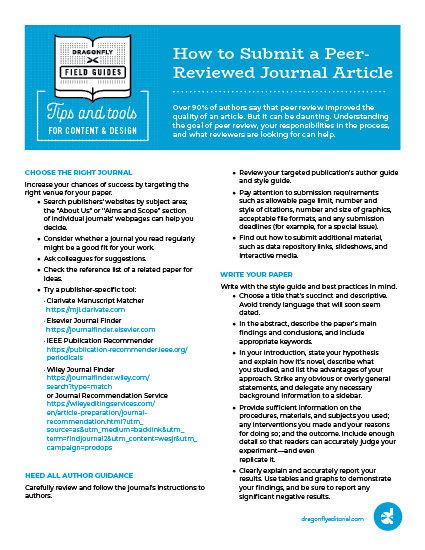Thinking about submitting an article to a peer-reviewed journal? Most authors find peer review valuable—91% said that it improved the quality of their article. That said, it can be daunting to face that gantlet of reviewers. Understanding the goal of peer review, your responsibilities in the process, and what reviewers are looking for can help you prepare.
CHOOSE THE RIGHT JOURNAL
Increase your chances of success by targeting the right venue for your paper.
- Search publishers’ websites by subject area; the
- “About Us” or “Aims and Scope” section of individual journals’ web pages can help you decide.
- Consider whether a journal you read regularly might be a good fit for your work.
- Ask colleagues for suggestions.
- Check the reference list of a related paper for ideas.
- Try a publisher-specific tool:
HEED ALL AUTHOR GUIDANCE
Carefully review and follow the journal’s instructions to authors.
- Review your targeted publication’s author guide and style guide.
- Pay attention to submission requirements such as allowable page limit, number and style of citations, number and size of graphics, acceptable file formats, and any submission deadlines (for example, for a special issue).
- Find out how to submit additional material, such as data repository links, slideshows, and interactive media.
WRITE YOUR PAPER
Write with the style guide and best practices in mind.
- Choose a title that’s succinct and descriptive. Avoid trendy language that will soon seem dated.
- In the abstract, describe the paper’s main findings and conclusions, and include appropriate keywords.
- In your introduction, state your hypothesis and explain how it’s novel, describe what you studied, and list the advantages of your approach. Strike any obvious or overly general statements, and delegate any necessary background information to a sidebar.
- Provide sufficient information on the procedures, materials, and subjects you used; any interventions you made and your reasons for doing so; and the outcome. Include enough detail so that readers can accurately judge your experiment—and even replicate it.
- Clearly explain and accurately report your results. Use tables and graphs to demonstrate your findings, and be sure to report any significant negative results.
- Explain how your work advances knowledge of the problem, and describe any limitations or negative results.
- Avoid summarizing your paper in the conclusion. Instead, discuss practical applications of your work, remaining questions, and any related future work you plan to undertake.
- Acknowledge those who helped or contributed to your research, and disclose any funding sources and conflicts of interest.
- Include any citations that are relevant to your work, including previous work of your own that your current paper builds on.
LOOK AT YOUR PAPER FROM THE REVIEWER’S PERSPECTIVE
Before submitting, do a quick quality check to be sure you’re not missing any important elements. Some questions reviewers will ask about your paper:
- Is it in scope with the aims and readership of the journal (or special issue)?
- Is it novel? Does it add a new method or concept to previous work?
- Is it valid? Is the study well designed and executed?
Is the data reported, analyzed, and interpreted correctly? Are the conclusions justified by the results?
- Is it clear? Is your writing concise and logical? Are your graphics, captions, and legends detailed and understandable? Would it benefit from being edited prior to submission?
- Is it a significant advancement to the field?
- Does it comply with the journal’s ethical requirements? Was it submitted to another journal simultaneously? Does the paper cite or acknowledge others’ work appropriately? Does it declare any conflicts of interest or sources of funding?
- Are the citations complete? Does the paper include citations that aren’t relevant to your work—or fail to cite important studies that are relevant? Do any statements lack necessary citations?
- Does it follow the author guide and instructions? Are you missing any required elements?
SUBMIT
After appraising your work from the reviewer’s perspective and addressing any deficiencies, you’re ready to submit. Follow the publication’s submission guidelines carefully to avoid being rejected without a review.
You’ll typically need to submit source files for the paper and for any illustrations, a PDF of the text and graphics, and permission approvals for any previously published material and graphics that you didn’t create yourself.
Then all you need to do is wait for the decision—knowing you did everything you could to position your paper for success.
REFERENCES:
Adrian Mulligan, Louise Hall, and Ellen Raphael, “Peer review in a changing world: An international study measuring the attitudes of researchers,” Journal of the American Society for Information Science and Technology, vol. 64, no. 1, January 2013, pp. 132-161, doi:10.1002/
asi.22798


